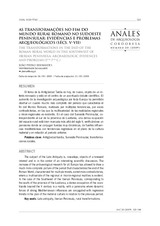As Transformações no fim do mundo rural romano no sudoeste peninsular: evidências e problemas arqueológicos (sécs. V-VII)
The Transformat ions in the End of the Roman Rural World in the Southwest of iberian Peninsula: archaeologic evidences and problems (5th-7th C.)

Ver/
Autor
Bernardes, Joào Pedro
Editor
Universidad de Córdoba, Área de ArqueologíaFecha
2009Materia
Antigüedad TardíaSuroeste Peninsular
Transformaciones rurales
Late antiquity
Iberian Peninsula
Rural transformations
METS:
Mostrar el registro METSPREMIS:
Mostrar el registro PREMISMetadatos
Mostrar el registro completo del ítemResumen
El tema de la Antigüedad Tardía es hoy, de nuevo, objeto de un interés renovado y está en el centro de un acentuado debate científico. El aumento de la investigación arqueológica por toda Europa ha permitido diseñar un cuadro mucho más completo del periodo que caracteriza el fin del Mundo Romano, matizado por múltiples tendencias, por voces contradictorias, en las que la multivariedad de las realidades regionales o micro-regionales es evidente. En el caso del Suroeste Peninsular, correspondiente al sur de la provincia de Lusitania, una densa ocupación del espacio rural está bien marcada más allá del siglo V, verificándose un panorama donde se conjugan fuerzas muy dinámicas, de fuertes influencias mediterráneas con tendencias regresivas en el plano de la cultura material y en relación al periodo anterior. The subject of the Late Antiquity is, nowadays, objects of a renewed interest and is in the center of an interesting scientific discussion. The increase of the archaeological research for all Europe has allowed to draw a much more complete picture of the period that characterizes the end of the Roman World, characterized for multiple trends, sometimes contradictories, where a multivariate of the regional or micron-regional realities is evident. In the case of the Southwest of the Iberian Peninsula, corresponding to the south of the province of the Lusitania, a dense occupation of the countryside beyond the V century is a reality, with a panorama where dynamic forces of strong Mediterranean influences are conjugated with regressive trends in the plan of the material culture in relation to the previous period.
